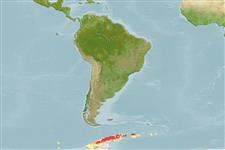Environment: milieu / climate zone / depth range / distribution range
Ecología
marino demersal; rango de profundidad 5 - 400 m. Polar; 60°S - 69°S
Southern Ocean: South Orkney, South Shetland, Elephant Islands and tip of Antarctic Peninsula to 65°S.
Tamaño / Peso / Age
Maturity: Lm ? range ? - ? cm
Max length : 42.0 cm SL macho / no sexado; (Ref. 5192)
Yolk larvae (2.3-3.2 cm TL) found from late October to early December; small juveniles from mid-January to mid-March, thus hatching may occur in late winter. Feeds on fish (Ref. 5192).
Life cycle and mating behavior
Madurez | Reproducción | Puesta | Huevos | Fecundidad | Larva
Gon, O., 1990. Bathydraconidae. p. 364-380. In O. Gon and P.C. Heemstra (eds.) Fishes of the Southern Ocean. J.L.B. Smith Institute of Ichthyology, Grahamstown, South Africa. 462 p. (Ref. 5192)
IUCN Red List Status (Ref. 130435)
Threat to humans
Harmless
Human uses
Pesquerías: sin interés
Más información
ReferenciasAcuiculturaPerfil de acuiculturaRazasGenéticaElectrophoresesheritabilidadEnfermedadesProcesamientoNutrientsMass conversion
ColaboradoresImágenesStamps, Coins Misc.SonidosCiguateraVelocidadTipo de nataciónSuperficie branquialOtolitosCerebrosVisión
Herramientas
Special reports
Download XML
Fuentes de Internet
Estimates based on models
Preferred temperature (Ref.
123201): -1.3 - 0.1, mean -0.9 °C (based on 23 cells).
Phylogenetic diversity index (Ref.
82804): PD
50 = 0.7500 [Uniqueness, from 0.5 = low to 2.0 = high].
Bayesian length-weight: a=0.00214 (0.00130 - 0.00351), b=3.21 (3.06 - 3.36), in cm total length, based on LWR estimates for this species & (Sub)family-body (Ref.
93245).
Nivel trófico (Ref.
69278): 4.2 ±0.7 se; based on diet studies.
Resiliencia (Ref.
120179): Medio, población duplicada en un tiempo mínimo de 1.4-4.4 años (Assuming Fec < 10,000).
Fishing Vulnerability (Ref.
59153): Moderate vulnerability (41 of 100).
